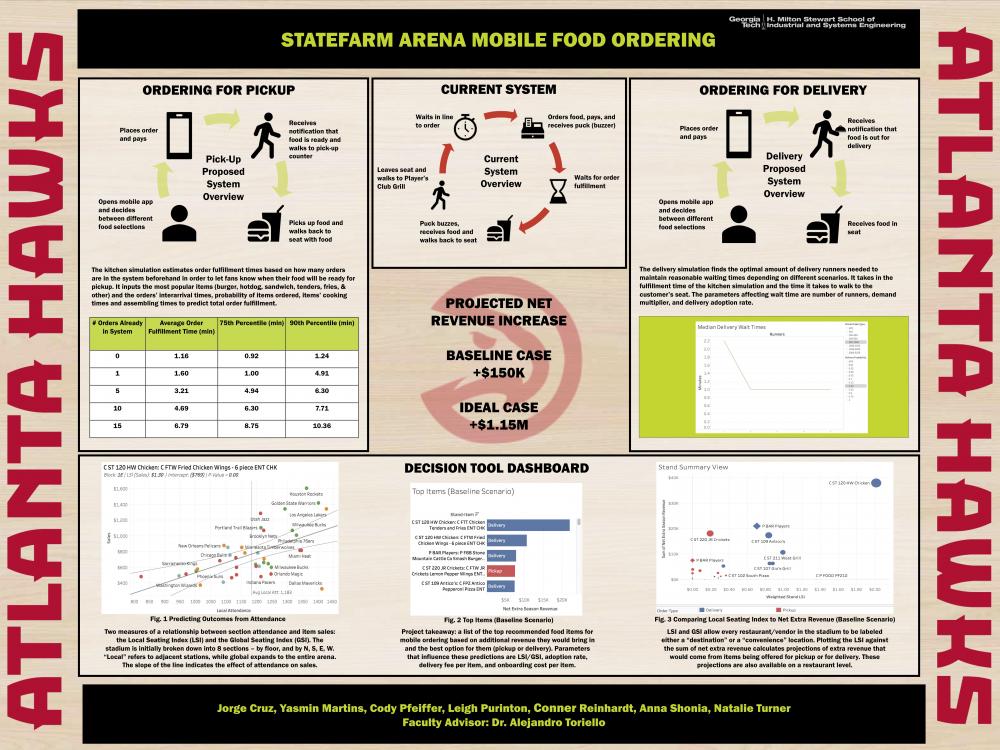Client Context
The Atlanta Hawks are an NBA franchise that own and operate StateFarm Arena, which hosts 200+ events, including sporting events, concerts, and business conventions, with more than two million guests a year. The Hawks are exploring the opportunity to improve overall customer experience, as well as the arena’s operations, by automating food and drink transactions with the implementation of a mobile food ordering system.
Project Objective
With the city of Atlanta becoming a hub for professional sports, it is imperative that the Hawks explore the option of mobile food ordering within StateFarm Arena to improve fan experience, which is their number one priority. Another goal of the Atlanta Hawks is to increase their conversion rate, the ratio of the total number of food/drink transactions to the total number of attendees during a game. StateFarm Arena currently has a conversion rate of 80%. A case study conducted by the Hawks’ current POS system, Appetize, reports, “The Sacramento Kings saw a 15% faster order turnaround time, a 30% higher average check size, and a 20% increase in overall sales transactions by utilizing Appetize’s mobile ordering application.”2 There are several other case studies, from this company alone, of other large stadiums, arenas, and amphitheaters with similar findings that support our hypothesis that mobile ordering will increase the total number of orders, as well as the average basket size per order.
With 39 vendors, finding food and drinks can be overwhelming for patrons. A mobile ordering system will organize the various options and make it easier for customers to find exactly what they are looking for. Along with purchasing food/drinks from any of the 39 vendors, patrons also have the option of sitting in one of the five premium clubs in the StateFarm Arena, four of which offer all-inclusive food and drink. The only club offering à la carte options is called the Player’s Club. This will be the testing environment for the future implementation of a mobile ordering system. It is an ideal testing environment for two reasons: 1) there is a specified number of ticket holders that are allowed access, and 2) it sells the typical fan-favorite food and drink items: hotdogs, hamburgers, fries, nachos, beer, etc.
The overall purpose of our project is to provide the Hawks with the information and tools needed to prepare them for the implementation of a mobile ordering system. The information package that we are providing gives the Hawks an understanding of order fulfillment times and feasibility of offering delivery in the Player’s Club, as well as a break-down of all food offerings in the stadium and their potential for ordering with pick-up or delivery.
Design Strategy
The proposed system will give customers the option to place their orders on their phones. The new system will cut out the time spent waiting in line for the customer’s order to be fulfilled, which is the most time consuming part. It will also cut out the time that customers in the Player’s Club spend waiting for their order to be fulfilled. The new system will display an estimated fulfillment time for each order once it is placed, to give customers an idea of when they will have to pick up their order. The customers will now be able to spend all of that time watching the game. An extension of the proposed system will be the option of having a delivery runner bring the customer’s order directly to their seat. The delivery runners will be given the customer’s seat location and order number. Both the pick up and delivery options are much more convenient for the customer, and align with the Hawks’ goal of providing customers with the best possible experience.
Deliverables
Our team developed a SimPy model to predict order completion time by using data collected through time studies of a kitchen in the arena, as well as order and time data from this kitchen from the 2018-2019 NBA season. The order fulfillment time will be integrated into the app to alert customers of their expected pick-up time at a designated location once they place an order. In addition, we constructed a second simulation of in-seat delivery to determine the most efficient number of runners to employ based on expected game attendance and desired delivery wait times. We provided the client with generated expected wait times, which can be integrated into the app, based off a simulation modeled after one of the arena’s kitchens.
Finally, we developed a decision tool to assess which of the available StateFarm Arena restaurants should be priority candidates for the mobile ordering app. These candidates were chosen as either a destination restaurant, specializing in unique fare, or as a convenience restaurant, servicing a specific area of the stadium. This decision tool is a key deliverable for our client to test out any number of scenarios with different inputs of expected demand and costs, which result in different projections of revenue based on these varying scenarios.
While our simulations need to be validated with pilot studies before implementation, these models provide important decision making information to decrease fan wait time in lines while also potentially increasing concession sales. We estimate a minimum revenue increase of about $150,000 per season with the implementation of mobile ordering. Additional value comes from an improvement of the customer experience: less time away from the game and easier access to food from all over the stadium increases guest satisfaction. This sets the Atlanta stadium on the path to achieving top customer experience in the world of sports.
A vital next step for introducing mobile food ordering is to find a successful validation method for the simulation. We ensured accurate results by timing processing times for every server in the simulation, but it is hard to say with certainty which time study will provide the best inputs, given that there are roughly 40 games in each game season, each with varying levels of attendance, target audiences, etc. It is also difficult to physically count and keep track of orders coming in and out of the system because of the busy nature of the environment. One method which might be beneficial would be to keep a record of the times that orders leave the system. The Atlanta Hawks only keep track of the timestamps of orders currently in the system, to prioritize orders that have been in the system for longer. Processing times would be useful to validate our simulation.
Our team created a survey that gauges interest for mobile food ordering by asking customers how likely they would be to use a mobile device to order food for pick-up and delivery. The survey has been sent out, but the responses are still pending. Although these results will not be numeric, they provide helpful insights on what to expect in terms of demand, as well as a loose prediction of the adoption rate for pickup and delivery. This can be used to set parameters in our decision tool.


